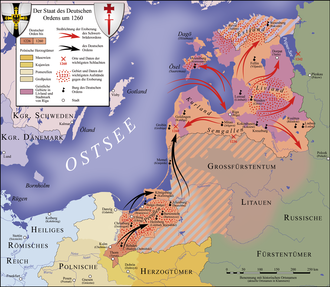Livonian Order
The structurally independent part of the Teutonic Order in the Baltic States is referred to as the Livonian Order or Livonian Order . After a devastating defeat in the Battle of Schaulen (1236) against the Livonians, the Order of the Brothers of the Swords was incorporated into the Teutonic Order , whose ownership was transferred to the Livonian Order , which was constituted in 1237, while maintaining its own Livonian administration .
The order of knights was part of the Teutonic Order State from 1237 to 1561 . With the battle on Lake Peipus in 1242, the eastward expansion of the united order was stopped.

history
The Order of the Brothers of the Swords, founded in Riga in 1202 (regalia: white coat with red cross and red sword) suffered a devastating defeat against the Baltic Shamaites , Lithuanians and Semgallians in the Battle of Schaulen in 1236 . Thereupon Hermann von Salza negotiated personally with the Curia the Union of Viterbo , as a result of which German orders and orders of the Brothers of the Sword were united. With the Livonian comers, a second heartland was acquired, the so-called Meistertum Livonia , where the already existing system of castles (so-called permanent houses ) was expanded on the model of Prussia .
In 1237 the landmaster in Prussia, Hermann Balk , arrived as the representative of Grand Master Hermann von Salza at the bishop in Riga, who was hard pressed by the pagan Lithuanians. The papally certified rights of the Teutonic Order were immediately recognized here. From then on a land master exercised the sovereign rights of the order in Livonia.
The immediately following military expansion to the east of the united order was finally stopped with the battle on Lake Peipus on April 5, 1242 and the recapture of the important trading center Pskow by a Christian-Orthodox Russian army under the leadership of Novgorod Prince Alexander Nevsky .
The Prussian and Livonian branches of the order remained separate, both administratively and territorially. In Livonia, in contrast to Prussia, there was a division of spheres of influence between the religious authority and various autonomous dioceses. Until the middle of the 14th century, some northern parts of Livonia belonged to the Kingdom of Denmark .
In addition, there was the different origins of the cadres of the two branches of the order: While Prussia was predominantly ruled by Central and West German monarchs, the corps of the Livonian branch of the order was mainly recruited from North German and Danish knights. This reflected the country's ties to the traditions of the violent proselytizing of the Livs and Estonians at the beginning of the 13th century: Christianity was spread in the northern Baltic region via pre-Hanseatic sea connections from bases such as Lübeck and the Danish Zealand .
In view of this constellation, coordinated activities of both branches of the order in the ongoing war against the Grand Duchy of Lithuania remained the exception. An outstanding example is the absence of the entire Livonian branch of the order during the decisive campaign of 1410, which led to the catastrophe at the Battle of Tannenberg . The Livonian landmaster Conrad von Vytinghove invoked an armistice agreed with the Lithuanian Grand Duke Vytautas . In the armed conflict between the Prussian monastic state and Poland and the Prussian Federation, the Livonian branch of the order remained largely neutral and was therefore not involved in negotiations with the Kingdom of Poland after the fighting ended. Prussia became a secular duchy in 1525, while the Livonian religious order was not secularized until 1561 to form the Duchy of Courland and Semgallia and the Duchy of Livonia .
See also
Remarks
- ↑ Hartmut Boockmann : The German Order. 12 chapters from its history . C. H. Beck, Munich 1981, p. 94.
- ^ Description of the situation in Livonia
- ^ Hermann von Salza negotiations in Viterbo
- ^ Theodor Hirsch , Max Toeppen , Ernst Strehlke : Scriptores rerum Prussicarum. The historical sources of the Prussian prehistoric times up to the fall of the order , 5 volumes. Leipzig 1861–1874. New edition Frankfurt am Main 1965. Volume 1, p. 395.
literature
- Friedrich Benninghoven : The order of the sword brothers: Fratres milicie Christi de Livonia. Böhlau, Cologne [a. a.] 1965
- Alain Demurger: The Knights of the Lord. History of the spiritual orders of knights. Beck, Munich 2003, ISBN 3-406-50282-2
- Wolfgang Sonthofen: The German Order. Weltbild, Augsburg 1995, ISBN 3-89350-713-2
- Dieter Zimmerling: The German order of knights. Econ, Munich 1998, ISBN 3-430-19959-X